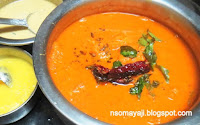Banana Stem dal is one of the healthy dish and it is said that at least once in a year you must eat banana stem. It helps to cleanse your intestine. It also helps to remove or reduce the stone in gal bladder.
Banana plant is one of the God's gift to mankind. Each part of this plant is used by man. Banana fruit to eat, banana leaf to have food, banana stem is used medicine. It has very good medicinal value and used in home remedy medicines.
Eating banana stem helps to cleanse our body and take care of our kidney. It helps to reduce or remove the stone formed in the kidney. It is said if have gulped the hair by chance it can bring out the hair from your body. But remember this stem should be used rarely. (Once in a while). Often used It heats up the body and you might get ulcer in your mouth, the eyes might turn red because of excess body heat.
Banana plant is one of the God's gift to mankind. Each part of this plant is used by man. Banana fruit to eat, banana leaf to have food, banana stem is used medicine. It has very good medicinal value and used in home remedy medicines.
Eating banana stem helps to cleanse our body and take care of our kidney. It helps to reduce or remove the stone formed in the kidney. It is said if have gulped the hair by chance it can bring out the hair from your body. But remember this stem should be used rarely. (Once in a while). Often used It heats up the body and you might get ulcer in your mouth, the eyes might turn red because of excess body heat.
I have used banana stem, moong dal, tamarind tokku (tender tamarind green chutney) and some green chilly.
Let us see the recipe now :
Things Needed :
Banana Stem : 1 Bowl
Moong Dal : 1/2 cup
Green chilly : 2 to 3
Tamarind Tokku : 1 Teaspoon full
Salt : As required
Ginger : An Inch
Ginger : An Inch
Seasoning :
Coconut Oil :1 Teaspoon
Mustard seeds : 1/2 Teaspoon
Jeera/Cumin seeds : 1/2 Teaspoon
1. Wash and cut banana stem and remove the thread you get while cutting.
2. Cut it into very small pieces. Wash and soak them in plain water.
3. Wash and put moong dal in a pressure cooker and add cut banana stem.
4. Add little water and cook for 3 to 4 minutes.( Or little more).
5. Wash and cut coriander leaves, curry leaves and slit green chilly.
6. Wash and remove the outer layer of ginger and wash it again. Grate the clean piece and keep it aside.
7. Keep a pan on the fire and add oil. Let it get hot. Add mustard seeds and let it splutter.
8. Add jeera and cut chilly. Fry for 10 seconds. Add ingh and curry leaves.
9. Add cooked banana stem and moong dal. Mix it well. Add little water, grated ginger and required salt.
10. Mix it nicely. Add turmeric powder. Cook for 2 to 3 minutes.
11. Add tamarind tokku if you have or add tamarind pulp. ( 1 Tablespoon).
12. Mix it well and cook for another 2 minutes. Shift Banana stem Dal to a serving dish.
13. Add cut coriander leaves and serve.
14. Adding a tablespoon of ghee helps to enhance the taste.
Adding any spice of your choice is optional. Adding tamarind pulp instead of tamarind tokku is optional. Adding more chilly and use of any cooking oil is optional. Adding water to get the thickness of the dal is optional. It taste better if it is bit thick. Do not get worried if the pieces are not soft and do not think they are not cooked well. They are bit hard even if cook them for long time even. So let the pieces be very small.
Time : 30 Minutes
Serves : 4 to 5.
2. Cut it into very small pieces. Wash and soak them in plain water.
3. Wash and put moong dal in a pressure cooker and add cut banana stem.
4. Add little water and cook for 3 to 4 minutes.( Or little more).
5. Wash and cut coriander leaves, curry leaves and slit green chilly.
6. Wash and remove the outer layer of ginger and wash it again. Grate the clean piece and keep it aside.
7. Keep a pan on the fire and add oil. Let it get hot. Add mustard seeds and let it splutter.
8. Add jeera and cut chilly. Fry for 10 seconds. Add ingh and curry leaves.
9. Add cooked banana stem and moong dal. Mix it well. Add little water, grated ginger and required salt.
10. Mix it nicely. Add turmeric powder. Cook for 2 to 3 minutes.
11. Add tamarind tokku if you have or add tamarind pulp. ( 1 Tablespoon).
12. Mix it well and cook for another 2 minutes. Shift Banana stem Dal to a serving dish.
13. Add cut coriander leaves and serve.
14. Adding a tablespoon of ghee helps to enhance the taste.
Note :
You should soak banana stem pieces quickly in plain water. It helps to retain white colour as it is.Adding any spice of your choice is optional. Adding tamarind pulp instead of tamarind tokku is optional. Adding more chilly and use of any cooking oil is optional. Adding water to get the thickness of the dal is optional. It taste better if it is bit thick. Do not get worried if the pieces are not soft and do not think they are not cooked well. They are bit hard even if cook them for long time even. So let the pieces be very small.
Time : 30 Minutes
Serves : 4 to 5.






















































